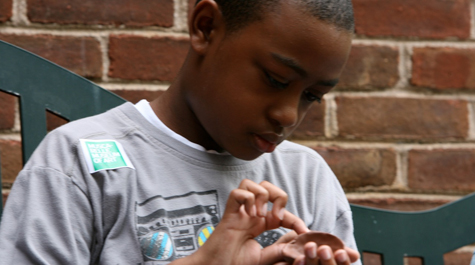Muscarelle: Where science meets art
Science and art – two seemingly different disciplines – intersected last week at the Muscarelle Museum of Art, yielding an educational and interactive fieldtrip for some 800 local elementary school children.
Third, fourth and fifth grade students from Williamsburg-James City County, Newport News, York and Hampton County, participated in the second annual “Science Behind Art” event. This year’s earth science theme featured activities on clay and soil, clouds and meteorology, patterns and nature and the physics of color, each tied back to elements and principles of design.
After a short geology lesson taught by William & Mary freshman and Muscarelle intern Jenny Hackett, she tasks the students with creating a pinch pot. Kyan Young, 9, from Phenix Elementary focuses in on a small ball of clay.
As Young’s fingers pinch the sides of his three-inch bowl, the malleable clay, once squishy and soft, begins to harden.
“We learned that clay doesn’t hold water and it’s not suitable for plant life,” said Young. He pauses, examines his masterpiece, and carefully uses a plastic knife to scrape the bottom of the pot, smoothing out the bumps.
Hackett says the lesson is two fold – teaching students the properties of clay and how clay is used for buildings, pottery and sculptures.
A groan comes over the group when Hackett tells them it’s time to put down their clay and move on to their next activity. The second session is a tour of the Muscarelle’s current exhibition, featuring ceramic artwork by retiring professor Marlene Jack. Soon they’ll see an array of objects such as bowls, plates, a teapot and sculptures, created from the very material once held in their hands.
Curator of Education Amy Gorman says the “Science Behind Art” outreach program allows the Muscarelle to serve a larger K-12 community than they normally could all year round.
“The event enables us to serve 200 plus kids in one day, so a school could bring their entire class,” she said.
On the other side of the Muscarelle, a group of Merrimack Elementary students funnel in for their second activity of the day: clouds and the water cycle, with the incorporation of value and depth artistic elements.
Volunteers Kari and Courtney Abbott, a mother-daughter duo, ask the group who can name the three cycles of water.
Hands fly in the air. One lucky student called upon answers “evaporation, condensation and precipitation.”
“Right!” Kari Abbott responds. Using colorful charts, she shows the class the various types of clouds such as cumulus, nimbostratus and stratus.
“Now look up to the sky and draw your own cloud,” directs Courtney. “Look at the variation of the shade of the clouds, some are darker than others.”
Quietness falls upon the class. The scratching of pencils can be heard on the concrete. Some students rub their fingers over their shaded clouds, creating a three-dimensional depth.
“I’m drawing a cumulus cloud,” says 9-year-old Jaylyn Arrington. When asked if she likes science or art better she immediately replies art. “You can learn how to do art,” she giggles.
Robyn O’Neal ’01, a teacher with Waller Mill Fine Arts Magnet, said she learned about the event through an email.
“The Muscarelle is a great, local resource,” said O’Neal. “This is a unique opportunity to integrate science and art curriculum, and is also a nice review for the students right before the SOLs.”
Some of O’Neal’s students perch in the front lawn of the Muscarelle. After learning about patterns and nature, they draw their own patterns to create a Styrofoam relief print.
Waller Mill student Taylor Horne says she looks to her surroundings for inspiration.
“I used the beads of my bracelet to draw circles,” says Horne. “I also drew hearts and stars because I started with curves and I wanted to add more curves. I also did circles with dots to make it look like crystals.”
Spoken like a true artist in the making. Or maybe a scientist.



















